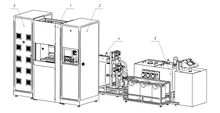Electrochemical removal
Electrochemical machining ( English Electro Chemical Machining , ECM ) or electrolytic machining is the generic term for a number of ablative manufacturing process , which the electrolysis make use.
The process is particularly suitable for very hard materials. Electrochemical removal is a cutting process . It is suitable for deburring, electropolishing and the production of complex three-dimensional workpieces.
A further development of classic ECM processes is PECM ( Pulsed Electrochemical Machining ) and PEM ( Precise Electrochemical Machining ), with which accuracies in the micrometer range ( micromachining ) are possible. Another variant for achieving higher accuracy is electrochemical micromilling (ECF).
The machining is similar to spark erosion (EDM). The ECDM method combines both methods.
description
The most important feature of the ECM process is the lack of contact between tool and workpiece . This means that no mechanical forces are transmitted and material properties such as hardness or toughness have no influence on the process. Properties such as melting point, thermal and electrical conductivity are important.
The workpiece is polarized as the anode (positive) and the tool as the cathode (negative). In most cases, an external voltage source is used to generate the current flow required for this. In some cases, however, as in metallography to make the microstructure visible, electrochemical etching is used. The potential difference in the micro range ( local element ) serves as an internal voltage source in order to achieve the desired material removal.
The shape of the tool cathode determines the shape of the workpiece. ECM is therefore a mapping process. There is no wear and tear on the tool due to the process. Depending on the electrical parameters and the flow conditions of the electrolyte, a gap must be set between the tool and the workpiece. The gap width is 0.05–1 mm.
The charge transport in the working gap is carried out by an electrolyte solution , e.g. B. aqueous solution of sodium chloride (NaCl, saline) or sodium nitrate (NaNO 3 ). The resulting electron current loosens metal ions from the workpiece. The dissolved metal ions then react at the anode with parts of the split electrolyte. The electrolyte residue reacts with water at the cathode. The end product is metal hydroxide , which settles as sludge and has to be removed.
Because the gap between the anode and cathode depends on electrical and fluid-mechanical conditions, it is difficult to calculate the shape of the cathode in advance. Because the interrelationships are easier to master, flat shapes (e.g. turbine blades) can be produced with less preparation.
The achievable surface quality is Rz = 3–10 µm. The edge zones are not influenced (only separating process without edge zone influence). The specific removal is 1–2.5 mm³ / min. The lowering speed is variable and lies between 0 and up to 20 mm / min. The electrolyte should be prepared by centrifugation to separate the metal hydroxides from the electrolyte solution. The resulting sludge is further dewatered with filter presses in order to then be disposed of as hazardous waste.
ECM is a process for machining electrically conductive workpieces that require targeted material removal. Materials in which ECM is applied are e.g. B. carbon steels , austenitic steels and nickel-based alloys . It goes beyond the limits of conventional machining.
The manufacturing process is used for:
- difficult to machine materials
- complicated shapes
- Processing in which no edge zone influence may occur
- preferably for flat shapes.
- Workpieces with internal bore intersections that are difficult to access with conventional tools (deburring)
Web links
- Chemnitz University of Technology (Professorship Microfabrication Technology): Lecture on ECM , accessed on July 5, 2015
- Kohler ECM: Electro-chemical-metalworking , explanation with animation, accessed on July 5, 2015
- EMAG GmbH: ECM - electrochemical metalworking , explanation of the technology with animation and infographics, accessed on July 12, 2017
- Extrude Hone: ECM - Electrochemical Ablation , Explanation of Technology with Infographics, on July 12, 2017
- PEMTec SNC: PECM - Precise electrochemical metalworking , explanation of the technology with infographics, on November 6, 2019.
- stoba Sondermaschinen GmbH: ECM - Electrochemical metalworking , explanation of the technology with infographics, on January 13, 2020

